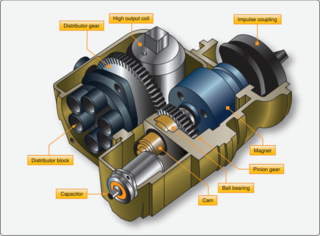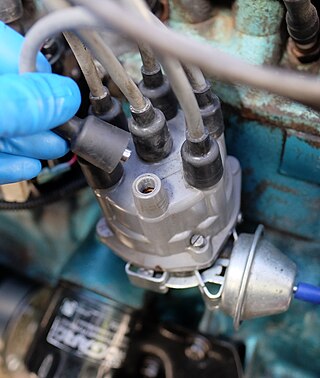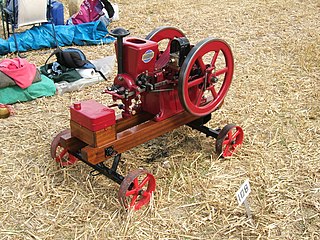
An ignition magneto is an older type of ignition system used in spark-ignition engines. It uses a magneto and a transformer to make pulses of high voltage for the spark plugs. The older term "high-tension" means "high-voltage".

A spark plug is an electrical device used in an internal combustion engine to produce a spark which ignites the air-fuel mixture in the combustion chamber. As part of the engine's ignition system, the spark plug receives high-voltage electricity which it uses to generate a spark in the small gap between the positive and negative electrodes. The timing of the spark is a key factor in the engine's behaviour, and the spark plug usually operates shortly before the combustion stroke commences.

An induction coil or "spark coil" is a type of electrical transformer used to produce high-voltage pulses from a low-voltage direct current (DC) supply. To create the flux changes necessary to induce voltage in the secondary coil, the direct current in the primary coil is repeatedly interrupted by a vibrating mechanical contact called an interrupter. Invented in 1836 by Nicholas Callan, with additional research by Charles Grafton Page and others, the induction coil was the first type of transformer. It was widely used in x-ray machines, spark-gap radio transmitters, arc lighting and quack medical electrotherapy devices from the 1880s to the 1920s. Today its only common use is as the ignition coils in internal combustion engines and in physics education to demonstrate induction.

Ignition systems are used by heat engines to initiate combustion by igniting the fuel-air mixture. In a spark ignition versions of the internal combustion engine, the ignition system creates a spark to ignite the fuel-air mixture just before each combustion stroke. Gas turbine engines and rocket engines normally use an ignition system only during start-up.

A contact breaker is a type of electrical switch, found in the ignition systems of spark-ignition internal combustion engines. The switch is automatically operated by a cam driven by the engine. The timing of operation of the switch is set so that a spark is produced at the right time to ignite the compressed air/fuel mixture in the cylinder of the engine. A mechanism may be provided to slightly adjust timing to allow for varying load on the engine. Since these contacts operate frequently, they are subject to wear, causing erratic ignition of the engine. More recent engines use electronic means to trigger the spark, which eliminated contact wear and allows computer control of ignition timing.

A distributor is an electric and mechanical device used in the ignition system of older spark ignition engines. The distributor's main function is to route electricity from the ignition coil to each spark plug at the correct time.
A wasted spark system is a type of ignition system used in some four-stroke cycle internal combustion engines. In a wasted spark system, the spark plugs fire in pairs, with one plug in a cylinder on its compression stroke and the other plug in a cylinder on its exhaust stroke. The extra spark during the exhaust stroke has no effect and is thus "wasted". This design halves the number of components necessary in a typical ignition system, while the extra spark, against much reduced dielectric resistance, barely impacts the lifespan of modern ignition components. In a typical engine, it requires only about 2–3 kV to fire the cylinder on its exhaust stroke. The remaining coil energy is available to fire the spark plug in the cylinder on its compression stroke.

Capacitor discharge ignition (CDI) or thyristor ignition is a type of automotive electronic ignition system which is widely used in outboard motors, motorcycles, lawn mowers, chainsaws, small engines, turbine-powered aircraft, and some cars. It was originally developed to overcome the long charging times associated with high inductance coils used in inductive discharge ignition (IDI) systems, making the ignition system more suitable for high engine speeds. The capacitive-discharge ignition uses capacitor discharge current to the coil to fire the spark plugs.

In a spark ignition internal combustion engine, ignition timing is the timing, relative to the current piston position and crankshaft angle, of the release of a spark in the combustion chamber near the end of the compression stroke.

A hit-and-miss engine or Hit 'N' Miss is a type of stationary internal combustion engine that is controlled by a governor to only fire at a set speed. They are usually 4-stroke but 2-stroke versions were made. It was conceived in the late 19th century and produced by various companies from the 1890s through approximately the 1940s. The name comes from the speed control on these engines: they fire ("hit") only when operating at or below a set speed, and cycle without firing ("miss") when they exceed their set speed. This is as compared to the "throttle governed" method of speed control. The sound made when the engine is running without a load is a distinctive "Snort POP whoosh whoosh whoosh whoosh snort POP" as the engine fires and then coasts until the speed decreases and it fires again to maintain its average speed. The snorting is caused by the atmospheric intake valve used on many of these engines.

A variety of types of electrical transformer are made for different purposes. Despite their design differences, the various types employ the same basic principle as discovered in 1831 by Michael Faraday, and share several key functional parts.

A low-tension coil is an electrical device used to create a spark across the points of an ignitor on early-1900s gasoline engines, generally flywheel engines, hit-and-miss engines, and other engines of that era. In modern electronic terms, a low-tension coil is simply a large inductor, an electrical device that stores energy for brief periods. The term "low tension" was the terminology of the day used to differentiate it from the term "high tension" and generally meant "low voltage" (tension) as opposed to "high voltage" (tension). High-tension coils produce high voltages, generally meant to produce a spark across a spark plug.
Trionic T5.5 is an engine management system in the Saab Trionic range. It controls ignition, fuel injection and turbo boost pressure. The system was introduced in the 1993 Saab 9000 2.3 Turbo with B234L and B234R engine.

Spark plug wires are electrical cables used by older internal combustion engines to transmit high-voltage electricity from the distributor to the spark plugs. Tension in this instance is a synonym for voltage. High tension may also be referred to as HT.
Inductive discharge ignition systems were developed in the 19th century as a means to ignite the air–fuel mixture in the combustion chamber of internal combustion engines. The first versions were low tension coils, then low-tension and in turn high-tension magnetos, which were offered as a more effective alternative to the older-design hot-tube ignitors that had been utilized earlier on hot tube engines. With the advent of small stationary engines; and with the development of the automobile, engine-driven tractors, and engine-driven trucks; first the magneto and later the distributor-type systems were utilized as part of an efficient and reliable engine ignition system on commercially available motorized equipment. These systems were in widespread use on all cars and trucks through the 1960s. Manufacturers such as Ford, General Motors, Chrysler, Citroen, Mercedes, John Deere, International Harvester, and many others incorporated them into their products. The inductive discharge system is still extensively used today.
The Delco ignition system, also known as the Kettering ignition system, points and condenser ignition or breaker point ignition, is a type of inductive discharge ignition system invented by Charles F. Kettering. It was first sold commercially on the 1912 Cadillac and was manufactured by Delco. Over time, it was used extensively by all automobile and truck manufacturers on spark ignition, i.e., gasoline engines. Today it is still widely used in coil-on-plug, coil-near-plug and in coil packs in distributorless ignitions. An alternative system used in automobiles is capacitor discharge ignition, primarily found now as aftermarket upgrade systems. Electronic ignition was a common term for Kettering inductive ignition with the points replaced with an electronic switch such as a transistor.

A magneto is an electrical generator that uses permanent magnets to produce periodic pulses of alternating current. Unlike a dynamo, a magneto does not contain a commutator to produce direct current. It is categorized as a form of alternator, although it is usually considered distinct from most other alternators, which use field coils rather than permanent magnets.

Dual Ignition is a system for spark-ignition engines, whereby critical ignition components, such as spark plugs and magnetos, are duplicated. Dual ignition is most commonly employed on aero engines, and is sometimes found on cars and motorcycles.

A trembler coil, buzz coil or vibrator coil is a type of high-voltage ignition coil used in the ignition system of early automobiles, most notably the Benz Patent-Motorwagen and the Ford Model T. Its distinguishing feature is a vibrating magnetically-activated contact called a trembler or interrupter, which breaks the primary current, generating multiple sparks during each cylinder's power stroke. Trembler coils were first used on the 1886 Benz automobile, and were used on the Model T until 1927.

An alternator is a type of electric generator used in modern automobiles to charge the battery and to power the electrical system when its engine is running.



















